Dorothy Davenport
| Dorothy Davenport | |
|---|---|
 Dorothy Davenport Reid in 1923 | |
| Born |
March 13, 1895 Boston, Massachusetts, U.S. |
| Died |
October 12, 1977 (aged 82) Los Angeles, California, U.S. |
| Resting place | Forest Lawn Memorial Park, Glendale |
| Years active | 1910–1956 |
| Spouse(s) | |
| Children | 2 |
| Parent(s) |
Harry Davenport (1866–1949) Alice Shepphard Davenport (1864–1936) |
Fannie Dorothy Davenport, Dorothy Davenport (March 13, 1895 – October 12, 1977) was an American actress, screenwriter, film director and producer. Davenport's family was heavily involved in the theater. Her father Harry Davenport was a comedian and her mother Alice Davenport was a well-known actress.[1] At a young age she began working in the fledgling film industry, and subsequently moved to California to work at Nestor Film Company. Davenport was a Hollywood star at age 17. While working at Nestor, Davenport met her future husband, actor Wallace Reid whom she married in 1913.
After the birth of her son in 1917, Davenport began to act less; however, she again gained notoriety when her husband Wallace Reid's career took off. Reid soon came under the spotlight as reports that he was a severely ill drug addict began to surface. Subsequently, Davenport became the source of information about her husband's condition, and after his death in January 1923 she co-produced Human Wreckage (1923). The film explores the dangers of narcotics addiction, and Davenport played the role of a drug addict's wife. Billed as "Mrs. Wallace Reid", she followed its success with other social-conscience films such as Broken Laws (1924) and The Red Kimono (1925) . After the release of The Red Kimono, California socialite Gabrielle Darley sued Davenport for 50,00 for using her name and life story without approval.
As her on-screen roles continued to diminish, she transitioned to directing, producing and screenwriting. Davenport's successful transition is often attributed to her range of positions in life, including mother, widow, Hollywood producer and social activist.[2]
While Davenport's company dissolved in the late 1920s, she continued to take on smaller writing and directing roles. In 1929 Davenport directed Linda a film about a woman who gives up her happiness for the sake of men and social expectations. Davenport directed her last film in 1934; however, she continued in the film industry in other roles until her last known credit in 1956 as dialogue supervisor of The First Traveling Saleslady.
Davenport died in October 1977 at the age of 82.[2]
Early career
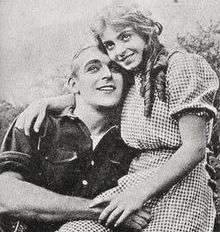
Davenport's family was well known in the theater. Her father, Harry Davenport, was a Broadway star and comedian, and her mother, Alice Davenport was a film actress who appeared in at least 140 films.[3] Dorothy's grandparents were 19th-century character actors, Edward Loomis Davenport, a successful tragedian stage actor and Fanny Vining Davenport, who began acting at the age of three. Their daughter and Dorothy's aunt, Fanny Davenport, was considered one of the great stage actresses of the time.[4]
Davenport's first professional role was in a stock company at the age of just six. At age fourteen, Davenport continued in the entertainment industry, doing a type of burlesque.[5]
At the age of just 16, she moved from Boston to Southern California to pursue acting. At the time, she was one of the first in the fledgling film industry. She began her career in what is now known as Hollywood with the Nestor Film Company, later acquired by Universal Pictures. Her first known film appearance was in Life Cycle in which she was cast as the supporting actress. By the time she was just 17 she was a star in the company, one of the outstanding members. She was a talented horsewoman, and did many of her own stunts in films.[2]
While with Nestor, Davenport met a young actor named Wallace Reid on the set of a film. Both were prominent within Nestor during the early years of the company and although Wallace Reid had left to pursue another film for six months, he promptly returned to Nestor and the pair married. They continued to work together as he directed and starred with her in two films per week for the next year.[6] After this year, the pair left universal to work on other films but returned in 1916. After the birth of her son Wallace Reid Jr. in 1917, Davenport took a break from acting to focus on being a mother.[2]
Personal life
Dorothy Davenport was born in Boston Massachusetts in 1895. Davenport attended school in Brooklyn and in Roanoke Virginia. By six years old Davenport had her first professional role. As a young girl she loved riding horses and playing outside After performing vaudeville for a year and a half, Davenport moved to Southern California at the age of 16.[5]
She married fellow Nestor company actor Wallace Reid in October 1913. "Called on to act with him in a film, she was frustrated by his apparent lack of acting ability on the first day, but was smitten with him on the third day of their work together."[6] The pair seemed to share a picturesque life as successful actors in the budding Hollywood. They worked on over a hundred films together the first year that they were married, and continued gaining notoriety.
On June 18, 1917 Davenport gave birth to her first son, Wallace Reid Jr, in Los Angeles California.[7] The birth of her son caused Davenport to take a step back from her career, and become a full time mother. In 1919 Davenport gave birth to the couple's second child, daughter Betty Anna Reid.
While filming on location in Oregon for The Valley of the Giants (1919), Davenport's husband, Wallace Reid was injured in a train wreck. As a remedy for the pain from this injury, studio doctors administered large doses of morphine to Reid to which he became addicted. Reid's health slowly grew worse over the next few years, and as the couple were prominent in the film industry, their personal lives also became a subject of the public's interest. Reid specifically was a target of speculation, when it was reported that he was put into a sanitarium for his drug addiction. Davenport became a sort of liaison between the media and her husband, reporting on his condition. Wallace Reid succumbed to his addiction on January 18 of 1923, prompting the beginning of her later career in the film industry, focused on social commentary films.[2]
After the release of her film The Red Kimono in 1925, Davenport was sued by Gabrielle Darley for using her name and story. After this lawsuit Davenport's directing career began to collapse, as she was bankrupted by the settlement.[8]
Later career
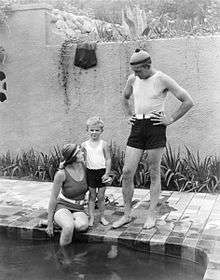
While filming on location in Oregon for The Valley of the Giants (1919), Wallace Reid was injured in a train wreck. As a remedy for the pain from this injury, studio doctors administered large doses of morphine to Reid to which he became addicted. Reid's health slowly grew worse over the next few years, and he died of the addiction in 1923. After Reid's death, Davenport and Thomas Ince co-produced the film Human Wreckage (1923) with James Kirkwood, Sr., Bessie Love and Lucille Ricksen, a film that dealt with the dangers of narcotics addiction. Davenport took Human Wreckage on a roadshow engagement, followed up with another "social conscience" picture about excessive mother-love called Broken Laws in 1924, again billed as "Mrs. Wallace Reid" to capitalize on her husband's notorious death.
Davenport then produced The Red Kimono (1925) about white slavery. On screen she opens the film in 'silent' narration or prologue. The subject of the "true story" film, a woman named Priscilla Bonner, was so obvious that Davenport was eventually sued by her. Bonner won the lawsuit and Davenport had to pay a large amount of money.[9] She later directed Linda (1929), Sucker Money (1933), Road to Ruin (1934), and The Woman Condemned (1934), and worked as a producer, writer, and dialogue director. Among her last credits are co-author of the screenplay for Footsteps in the Fog (1955), and as dialogue director for The First Traveling Saleslady (1956) with Ginger Rogers. In the 1970s near the end of her life, Dorothy still had a print of her husband's 1921 feature Forever. She gave the print to an organization planning a museum. The museum plans fell through and Dorothy's last remaining print of her favorite movie of Wally's was lost.
Cinema
Human Wreckage
Davenport's body of work was largely reflective of her tumultuous marriage to Wallace Reid. Davenport's 1923 lost silent film Human Wreckage was the first film after the death of her husband earlier that year. Davenport and Thomas Ince directed the film in which Davenport stars as the wife of a drug addict. "Ethel McFarland (Davenport) presents her attorney husband, Alan (Kirkwood), with the case of a dope addict named Jimmy Brown (Hackathorne). With the help of Alan's impassioned defense, Jimmy gets acquitted. Alan feels the pressures of his job and is introduced to a doctor at his club. When he becomes addicted, he is blackmailed by his peddlers to represent their friends in court. Jimmy, now off the smack and a taxi driver, hears of these goings-on. When he discovers that his passenger is the leader of the dope ring, he resolves to aid the war on narcotics by crashing the vehicle head-on into an oncoming train, killing them both. Alan gets treated for his addiction and begins to fight the pushers in court, all the while pushing for stronger laws against addictive substances. At the film's close, the film's producer, Dorothy Davenport, who plays Ethel, and who was Wallace Reid's wife, addresses the audience directly, imploring them to support her in her crusade to wipe out the menace of narcotics."[10]
The Red Kimono
Both written and directed by Davenport, the 1925 silent film starred Priscilla Bonner as a prostitute in New Orleans. (add more about the actual film). After the release of the film, Gabrielle Melvin sued Davenport, claiming that she had not given Davenport permission to use the details of her life in the film. She claimed that the film exposed her and left her subject to humiliation.[2]
Broken Laws
Davenport produced and starred in this 1924 silent film about the relationship between a mother and her son. "Joan Allen (Davenport) is a loving mother who can't help indulging her son Bobby, spoiling him to the point where he is an irresponsible "jazz-mad" teenager on trial for vehicular manslaughter. She wakes up with a start at the end of the trial, with new resolve to provide the right amount of parental discipline."[11]
Death
On October 12, 1977, Davenport died at the Motion Picture & Television Country House and Hospital in Woodland Hills, California. She is interred with Wallace Reid at Forest Lawn Memorial Park, Glendale.
Select filmography
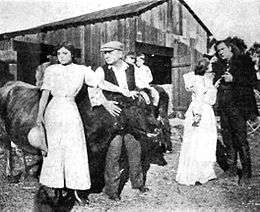

_-_Davenport_%26_Cuneo.jpg)
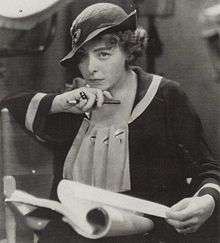
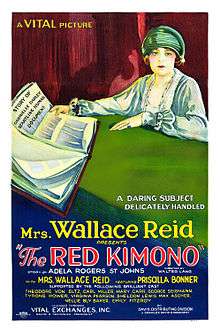
| Year | Title | Role | Notes |
|---|---|---|---|
| 1910 | The Troublesome Baby | Cast member | [12] |
| 1911 | The Best Man Wins | Cast member | [13] |
| 1912 | His Only Son | Cast member | [2] |
| 1915 | The Explorer | Lucy Allerton | [12] |
| 1915 | Mr. Grex of Monte Carlo | Grand Duchess Feodora | [12] |
| 1915 | The Unknown | Nancy Preston | [12] |
| 1916 | A Yoke of Gold | Carmen | [12] |
| 1916 | The Devil's Bondwoman | Beverly Hope | [12] |
| 1916 | Barriers of Society | Martha Gorham | [12] |
| 1916 | Doctor Neighbor | Hazel Rogers | [12] |
| 1916 | The Unattainable | Bessie Gale | [12] |
| 1916 | Black Friday | Elinor Rossitor | [12] |
| 1916 | The Way of the World | Beatrice Farley | [12] |
| 1917 | The Squaw Man's Son | Edith, Lady Effington | [12] |
| 1917 | The Girl and the Crisis | Ellen Wilmot | [12] |
| 1917 | Mothers of Men | Clara Madison | [12] |
| 1917 | The Scarlet Crystal | Marie Delys | [12] |
| 1917 | Treason | Luella Brysk | [12] |
| 1920 | The Fighting Chance | Leila Mortimer | [12] |
| 1921 | Every Woman's Problem | Clara Madison | [12] |
| 1922 | The Masked Avenger | Valerie Putnam | as Mrs. Wallace Reid[12] |
| 1923 | Human Wreckage | Ethel MacFarland | as Mrs. Wallace Reid[12] |
| 1924 | Broken Laws | Joan Allen | as Mrs. Wallace Reid[12] |
| 1925 | The Red Kimono | Herself | Prologue, as Mrs. Wallace Reid[12] |
| 1926 | The Earth Woman | Producer, as Mrs. Wallace Reid[12] | |
| 1927 | The Satin Woman | Mrs. Jean Taylor | as Mrs. Wallace Reid[12] |
| 1928 | Hellship Bronson | Mrs. Bronson | as Mrs. Wallace Reid[12] |
| 1929 | Linda | Director, as Mrs. Wallace Reid[12] | |
| 1926 | The Dude Wrangler | Producer, as Mrs. Wallace Reid[12] | |
| 1932 | The Racing Strain | Writer (story), as Mrs. Wallace Reid[12] | |
| 1933 | Man Hunt | Mrs. Scott | as Mrs. Wallace Reid[12] |
| 1933 | Sucker Money | Co-director, as Dorothy Reid[12] | |
| 1934 | The Road to Ruin | Mrs. Merrill | Also director and writer (story), as Mrs. Wallace Reid[12] |
| 1934 | The Woman Condemned | Director, as Mrs. Wallace Reid[12] | |
| 1935 | Redhead | Producer, as Dorothy Reid[12] | |
| 1935 | Honeymoon, Limited | Producer and screenwriter, as Dorothy Reid[12] | |
| 1935 | Two Sinners | Story supervisor, as Mrs. Wallace Reid[12] | |
| 1935 | Women Must Dress | Writer (story and screenplay), as Dorothy Reid[12] | |
| 1936 | The House of a Thousand Candles | Producer, as Dorothy Reid[12] | |
| 1937 | Paradise Isle | Producer, as Dorothy Reid[12] | |
| 1937 | A Bride for Henry | Producer, as Dorothy Reid[12] | |
| 1938 | Prison Break | Screenwriter, as Dorothy Reid[12] | |
| 1938 | Rose of the Rio Grande | Producer, as Dorothy Reid[12] | |
| 1940 | The Old Swimmin' Hole | Screenwriter, as Dorothy Reid[12] | |
| 1947 | Curley | Screenwriter, as Dorothy Reid[12] | |
| 1948 | Who Killed Doc Robbin | Screenwriter, as Dorothy Reid[12] | |
| 1949 | Impact | Screenwriter, as Dorothy Reid[12] | |
| 1951 | Rhubarb | Screenwriter, as Dorothy Reid[12] | |
| 1952 | It Grows on Trees | Dialogue coach, as Dorothy Reid[12] | |
| 1954 | Francis Covers the Big Town | Dialogue director, as Dorothy Reid[12] | |
| 1955 | Footsteps in the Fog | Screenwriter, as Dorothy Reid[12] | |
| 1956 | The First Traveling Saleslady | Dialogue supervisor, as Dorothy Reid[12] |
References
- ↑ "Motion picture news: DOROTHY DAVENPORT". The Billboard (Archive: 1894-1960). October 7, 1911.
- 1 2 3 4 5 6 7 Anderson, Mark Lynn (September 27, 2013). "Dorothy Davenport Reid". Women Film Pioneers Project. Center for Digital Research and Scholarship, Columbia University Libraries. Retrieved 2016-08-09.
- ↑ "Alice Davenport". Wikipedia. 2018-02-03.
- ↑ "Fanny Vining Davenport". Wikipedia. 2018-02-06.
- 1 2 The Movie Magazine: A National Motion Picture Magazine ... Movie Magazine Publishing Company, Incorporated. 1915.
- 1 2 "Dorothy Davenport". IMDb. Retrieved 2018-04-13.
- ↑ "Wallace Reid Jr". IMDb. Retrieved 2018-04-13.
- ↑ McMahan, Alison (2000). "FIRST LADIES: EARLY WOMEN FILMMAKERS, 1915—1925". Cinéaste. 26 (1): 58–59. JSTOR 41689323.
- ↑ Friedman, Lawrence M. (2007). Guarding life's dark secrets : legal and social controls over reputation, propriety, and privacy. Stanford, Calif.: Stanford University Press. pp. 217–225. ISBN 978-0-8047-5739-3.
- ↑ "Human Wreckage". Wikipedia. 2017-08-31.
- ↑ "Broken Laws". Wikipedia. 2017-02-06.
- 1 2 3 4 5 6 7 8 9 10 11 12 13 14 15 16 17 18 19 20 21 22 23 24 25 26 27 28 29 30 31 32 33 34 35 36 37 38 39 40 41 42 43 44 45 46 47 48 49 50 "Dorothy Davenport". AFI Catalog of Feature Films. American Film Institute. Retrieved 2016-08-09.
- ↑ "Thomas Ricketts, Pioneer of Movies". The New York Times. January 21, 1939. Retrieved 2016-02-12.
External links
| Wikimedia Commons has media related to Dorothy Davenport. |
- Dorothy Davenport on IMDb
- Dorothy Davenport Reid at the Women Film Pioneers Project
- Dorothy Davenport at Find a Grave
- Elderly Dorothy, 1970s